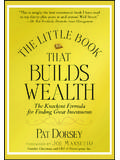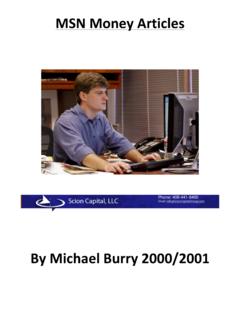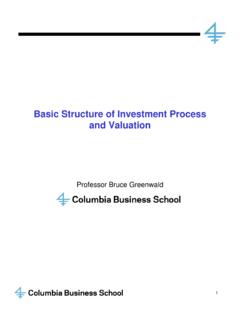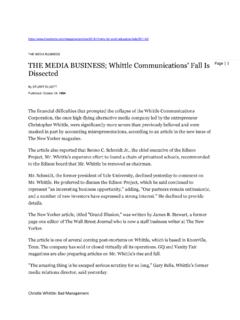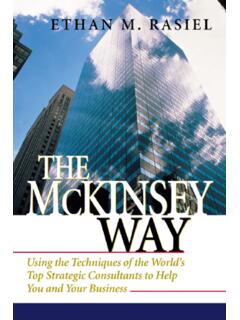Transcription of Do Stocks Outperform Treasury Bills.Feb18 - csinvesting
1 Do Stocks Outperform Treasury Bills?*. Initial Draft: January 2017. Current Draft: February 2017. Hendrik Bessembinder Department of Finance Carey School of Business Arizona State University Abstract Most common Stocks do not Outperform Treasury Bills. Fifty eight percent of common Stocks have holding period returns less than those on one-month Treasuries over their full lifetimes on CRSP. When stated in terms of lifetime dollar wealth creation, the entire gain in the stock market since 1926 is attributable to the best-performing four percent of listed Stocks . These results highlight the important role of positive skewness in the cross-sectional distribution of stock returns. The skewness in long-horizon returns reflects both that monthly returns are positively skewed and the fact that compounding returns itself induces positive skewness.
2 The results also help to explain why active strategies, which tend to be poorly diversified, most often underperform. *I thank Jennifer Conrad, Wayne Ferson, Campbell Harvey, Mike Cooper, Feng Zhang, Todd Mitton, Ed Rice, Luke Stein, Sunil Wahal, George Aragon, Seth Pruitt, David Schreindorfer, Kumar Venkataraman, Baozhong Yang and seminar participants at Arizona State University for valuable comments, and Goeun Choi for research assistance. Do Stocks Outperform Treasury Bills? I. Introduction The question posed in the title of this paper may seem nonsensical. The fact that stock markets provide long term returns that exceed the returns provided by low risk investments such as government obligations has been extensively documented, for the stock market as well as for many other In fact, the degree to which stock markets Outperform low risk investments is so large that the magnitude of the observed stock market return premium is widely referred to as the equity premium puzzle.
3 2. In this paper, I document that most common Stocks provide returns that fall short of those earned on one-month Treasury I rely on the CRSP monthly stock return database, which contains all common Stocks listed on the NYSE, Amex, and NASDAQ exchanges. Of all monthly common stock returns contained in the CRSP database from 1926 to 2015, only are larger than the one-month Treasury rate. In fact, less than half of monthly CRSP common stock returns are positive. When focusing on lifetime returns (from the beginning of sample or first appearance in CRSP through the end of sample or delisting from CRSP, and including delisting returns when appropriate), just of common Stocks have a holding period return 1. See, for example, the evidence compiled in chapter 10 of Corporate Finance, by Stephen Ross, Randolph Westerfield, and Jeffrey Jaffe, McGraw Hill Irwin, 2013.
4 2. Mehra and Prescott (1984) first drew attention to the magnitude of the equity premium for the broad stock market. Dozens of papers have since sought to explain the premium. The equity premium is most often measured by market returns that are constructed as capitalization weighted averages of returns to individual securities. Those studies that consider equal weighted average returns generally report even higher stock market performance. 3. Since first circulating this paper, I have become aware of blog posts that document findings with a similar, but less comprehensive, flavor. See The risks of owning individual Stocks at risks of owning an individual stock/ and The capitalism distribution at content/uploads/2008/12 1 that exceeds the return to holding one-month Treasury Bills over the same horizon, and more than half deliver negative lifetime returns.
5 Individual common Stocks tend to have rather short lives. The median time that a stock is listed on the CRSP database between 1926 and 2015 is just over seven years. To assess whether individual Stocks generate positive returns over the full ninety years of available CRSP data, I. conduct bootstrap simulations. In particular, I assess the likelihood that a strategy that holds one stock selected at random during each month from 1926 to 2015 would have generated a 90-year holding period return (ignoring any transaction costs) that exceeds various benchmarks. In light of the well-documented small-firm effect (whereby smaller firms earn higher average returns than large, as originally documented by Banz, 1980) it might be been anticipated that individual Stocks would tend to Outperform the value-weighted market.
6 In fact, repeating the random selection process many times, I find that the single stock strategy underperformed the value- weighted market in ninety six percent of the simulations, and underperformed the equal-weighed market in ninety nine percent of the The single-stock strategy outperformed the one-month Treasury bill over the 1926 to 2015 period in only twenty eight percent of the simulations. The fact that the overall stock market generates puzzling high long term returns while the majority of individual Stocks fail to even match T-bills can be attributed to the fact that the cross- sectional distribution of stock returns is positively Simply put, large positive returns 4. The equal weighted market return exceeds the value weighted return over long time periods, and thus provides a higher hurdle, both because of the small firm effect and because of the active rebalancing implicit in equal weighting.
7 For discussion, see Asparouhova, Bessembinder, and Kalcheva (2013). 5. That individual stock returns are positively skewed, and that return skewness declines as portfolios are diversified, has been recognized at least since Simkowitz and Beedles (1978). Numerous authors have assessed the cross sectional relation between mean returns and skewness (either individual Stocks return skewness or the co skewness of stock returns with the broader market, generally reporting lower returns for more highly skewed Stocks , consistent with an investor preference for skewness as implied by Kraus and Litzenberger (1976). See for example Harvey and Siddique (2000), Mitton and Vorkink (2007), Conrad, Dittmar and Ghysels (2013) and Amaya, Christoffersen, Jacobs, and Vasquez (2015).)
8 2 are more frequent than large negative returns. The importance of positive skewness in the cross- sectional return distribution increases for longer holding periods, due to the effects of compounding. Perhaps the most striking illustration of the importance of individual stock skewness to stock market performance arises when measuring aggregate stock market wealth creation. I. calculate that the approximately 26,000 Stocks that have appeared in the CRSP database since 1926 are collectively responsible for lifetime shareholder wealth creation of nearly $32 trillion dollars, measured as of December 2015. However, the eighty six top-performing Stocks , less than one third of one percent of the total, collectively account for over half of the wealth creation.
9 The 1,000 top performing Stocks , less than four percent of the total, account for all of the wealth creation. That is, the other ninety six percent of Stocks that have appeared on CRSP. collectively generated lifetime dollar returns that only match the one-month Treasury bill . At first glance, the finding that most Stocks generate negative lifetime return premia (relative to Treasury Bills) is difficult to reconcile with models that presume investors to be risk- averse, since those models imply a positive anticipated return The Capital Asset Pricing Model (CAPM) in particular implies that each individual stock's expected return premium is the stock's beta times the positive expected market-wide premium. Given positive betas, each stock's expected return premium should be positive.
10 Note, however, that implications of standard asset pricing models, including the CAPM, are with regard to Stocks ' mean excess return, while the fact that the majority of common stock returns are less than the Treasury rate reveals that the median excess return is negative. The 6. I will use the terms return premium and excess return interchangeably, in each case referring to the difference between the stock return and the Treasury return. 3 CAPM in particular relies on the assumption that stock returns are normally distributed, in which case mean and median returns are equal. The evidence reported here is at indeed at odds with the CAPM, but the conflict arises from the fact that the median stock return is less than the mean return.

